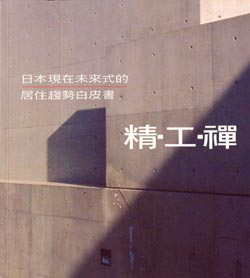Mar , 2004
富而好禮的人文居住思潮

撰文/ 誠寬建設總經理
「精‧工‧禪」是黃宏輝建築師多年來閱歷日本各地建築,篩選生態自然、科技手工、簡素禪定...等深入精神層面的個案,由德高望重的美術學者王行恭老師、創意作家李欣頻小姐、新銳導演施書銘先生時地拍攝合力完成,橫跨老、中、青的創意組合,所呈現的書的風貌,就向書內容提到的東京台場K-Museum蘆葦燈,有一種異次元之美,為建築出版點亮起燎原的驚豔。
這本書所介紹的建築個案,皆呈現如雲淡風清般低調「禪」愫,看似老子的無為,卻在幕後作了許多「精、工」─無盡而高明的思考、鋪陳、推演,為佈局往後可能呈現的生活情境預留伏筆,讓人與建築與環境產生良好的互動;讓居住者得以在有限的空間品啜天癩、地籟、人瀨,沉潛於無限無邊的生活真味。
因為尊重然,在神戶六甲、星田共有城市、綠園都市、福岡香椎...等個案,發現建築師不再對自然做無理的要求,而是退讓更多地給自然,與之共生,低調極簡,使自然與人文,建築與環境相互交融,展現建築的低限美學,處處盈滿天地宇宙的謙沖曠達。
因為熱愛生命,飛驟古川由一個默默無聞的古城,一條不起眼的小水道,放養了錦鯉,就奇蹟似地有了態度、有了故事、有了靈感、有了音樂、有了情節。就像老子道德經提到「上善若水,水善利萬物而不爭...,居善地,心善淵,與善仁,言善信...」因為不爭,讓出魚、讓出生存的空間,住戶之間也因為有了這些魚、水道的連貫,串連出守望和睦的綿密情感,有了共同的人文榮耀與精神歸屬;意外地為社區創造了“富而好禮”的精神價值,並榮獲「故鄉營造大獎」。看到這裡,內心感動,久久不能自己。這樣的社區營造個案,可說是“建築的精神文明”,帶給我們對台灣建築的規劃有了新的態度與省思。
良好的建築規劃,應是自然而謙遜的態度。就像老子的「上善若水」,學習像水一樣,涓滴長流、方圓依物、曲直隨形,儘管歷經冬凝夏融之後,隨風潛入,潤物無聲;“水”總是展現最貼近地面的謙遜態度,順應自然,而與世無爭。久居期間,心胸自然深澈澄明。
鷺飛草長時節,各地花訊遍傳,有喜鵲、松鼠、雀躍,有錦鯉魚戲在飄如雪的落櫻繽紛...,在前、中、後院,有天籟、地籟、人籟餘音繞樑...,讓我們共同期待富而好禮的人文建築能早日實現。
誠寬建設總經理
in May, 2004
本文轉載自日本現在未來式的居住趨勢白皮書「精工禪」第9頁
特別感謝:麥浩斯資訊股份有限公司與行銷經理林孟葦小姐誠寬建設總經理劉煥然先生
不吝此文刊載於tbdc網站
富而好禮的人文居住思潮

撰文/ 誠寬建設總經理
「精‧工‧禪」是黃宏輝建築師多年來閱歷日本各地建築,篩選生態自然、科技手工、簡素禪定...等深入精神層面的個案,由德高望重的美術學者王行恭老師、創意作家李欣頻小姐、新銳導演施書銘先生時地拍攝合力完成,橫跨老、中、青的創意組合,所呈現的書的風貌,就向書內容提到的東京台場K-Museum蘆葦燈,有一種異次元之美,為建築出版點亮起燎原的驚豔。
這本書所介紹的建築個案,皆呈現如雲淡風清般低調「禪」愫,看似老子的無為,卻在幕後作了許多「精、工」─無盡而高明的思考、鋪陳、推演,為佈局往後可能呈現的生活情境預留伏筆,讓人與建築與環境產生良好的互動;讓居住者得以在有限的空間品啜天癩、地籟、人瀨,沉潛於無限無邊的生活真味。
因為尊重然,在神戶六甲、星田共有城市、綠園都市、福岡香椎...等個案,發現建築師不再對自然做無理的要求,而是退讓更多地給自然,與之共生,低調極簡,使自然與人文,建築與環境相互交融,展現建築的低限美學,處處盈滿天地宇宙的謙沖曠達。
因為熱愛生命,飛驟古川由一個默默無聞的古城,一條不起眼的小水道,放養了錦鯉,就奇蹟似地有了態度、有了故事、有了靈感、有了音樂、有了情節。就像老子道德經提到「上善若水,水善利萬物而不爭...,居善地,心善淵,與善仁,言善信...」因為不爭,讓出魚、讓出生存的空間,住戶之間也因為有了這些魚、水道的連貫,串連出守望和睦的綿密情感,有了共同的人文榮耀與精神歸屬;意外地為社區創造了“富而好禮”的精神價值,並榮獲「故鄉營造大獎」。看到這裡,內心感動,久久不能自己。這樣的社區營造個案,可說是“建築的精神文明”,帶給我們對台灣建築的規劃有了新的態度與省思。
良好的建築規劃,應是自然而謙遜的態度。就像老子的「上善若水」,學習像水一樣,涓滴長流、方圓依物、曲直隨形,儘管歷經冬凝夏融之後,隨風潛入,潤物無聲;“水”總是展現最貼近地面的謙遜態度,順應自然,而與世無爭。久居期間,心胸自然深澈澄明。
鷺飛草長時節,各地花訊遍傳,有喜鵲、松鼠、雀躍,有錦鯉魚戲在飄如雪的落櫻繽紛...,在前、中、後院,有天籟、地籟、人籟餘音繞樑...,讓我們共同期待富而好禮的人文建築能早日實現。
誠寬建設總經理
in May, 2004
本文轉載自日本現在未來式的居住趨勢白皮書「精工禪」第9頁
特別感謝:麥浩斯資訊股份有限公司與行銷經理林孟葦小姐誠寬建設總經理劉煥然先生
不吝此文刊載於tbdc網站
Delicacy, Good, Zen
By Manager of Cheng-Kuan Constuction Firm
“Delicacy, Good, Zen” is a book about cases observed by Mr. Hong-Hui Huang,an architect. He spent several years researching the Japanese architecture and screening out some cases that involve deep psychological aspects that are natural & ecological, technical & hand-made and simple & Zen. The book is completed in collaboration with the photography taken by Xing-Gong Wang, a virtuous fine art scholar, Hsin-Pin Lee, a creative writer and Shu-Ming Shih, a new and prominent film director. It is a project completed by senior, mid-aged, and young talents. This book presents a special style and features the bulrush lamp in Tokyo K-Museum in one of chapters exhibiting a beauty of sub-dimension. It brings the architecture publishers a surprising light.
The architectural cases introduced in this book all present a light and easy sense of “Zen.” On the surface, they look like Lao-Tzu’s Taoism, but contain delicacy and goodness, which brings an endless space for readers to think, describe, and deduce. It also foreshadows the living environment in the future, creates a wonderful interaction among people, the environment, and architecture, and allows habitants in the definite space to immerse themselves in such an infinite joy of interaction among sky, earth, and humans.
Due to the respect for nature, in cases of cities, green metropolitan, and Nextus in Rokko Island, Kobe and Hoshida (星田), that the architects no longer fight with nature, but try to bring “mutualism” to humans and nature. They design things with low profile, simplicity, and merge nature and humanity, architecture and environment altogether, which presents a minimal esthetics in architecture, and give the universe great admiration.
Because of the passion toward life, Hida Furukawa (飛驟古川) is transformed from a small ditch at a recondite old town, into something magically has its own life, story, spirit, and muse after putting in variegated carp to breed. Lao Tzu said in his Tao Te Jing: “The highest virtue is like water. Water benefits all, but does not contend with them… In your dwelling, be close to the land; in meditation, go deep in the heart; in dealing with others, be gentle and kind; in speech, be true…” Not striving with nature, so carps have room to survive. Habitants feel the harmonious atmosphere and spirit of humanity because of the water and fish. Those surprisingly create a value of “rich and good ritual.” Also, the project won the first prize of “Constructing Your Hometown Award.”(故鄉營造大獎) I was moved as I read this book. This case of re-establishing a community shows the “spirit of architecture,” and brings us a brand new attitude as well as reflection towards Taiwan’s architecture.
Good architecture planning should be humble to nature. As Lao Tzu’s “The highest virtue is like water,” we should learn from water, which dribbles slowly, and follows the way it is. Water always flows quietly wherever it should go in four seasons, humbly nestles up to the earth, adjusts itself to the nature, and holds itself aloof from the world. Staying in such a nice atmosphere, your mind will be naturally refreshed.
As egrets flying and flowers blooming, magpies and squirrels prancing about everywhere, and variegate carps playing around the petals falling in riotous profusion, music from heavy, earth, and human spreading, let’s look forward to a wonderful community of richness and good virtue.


